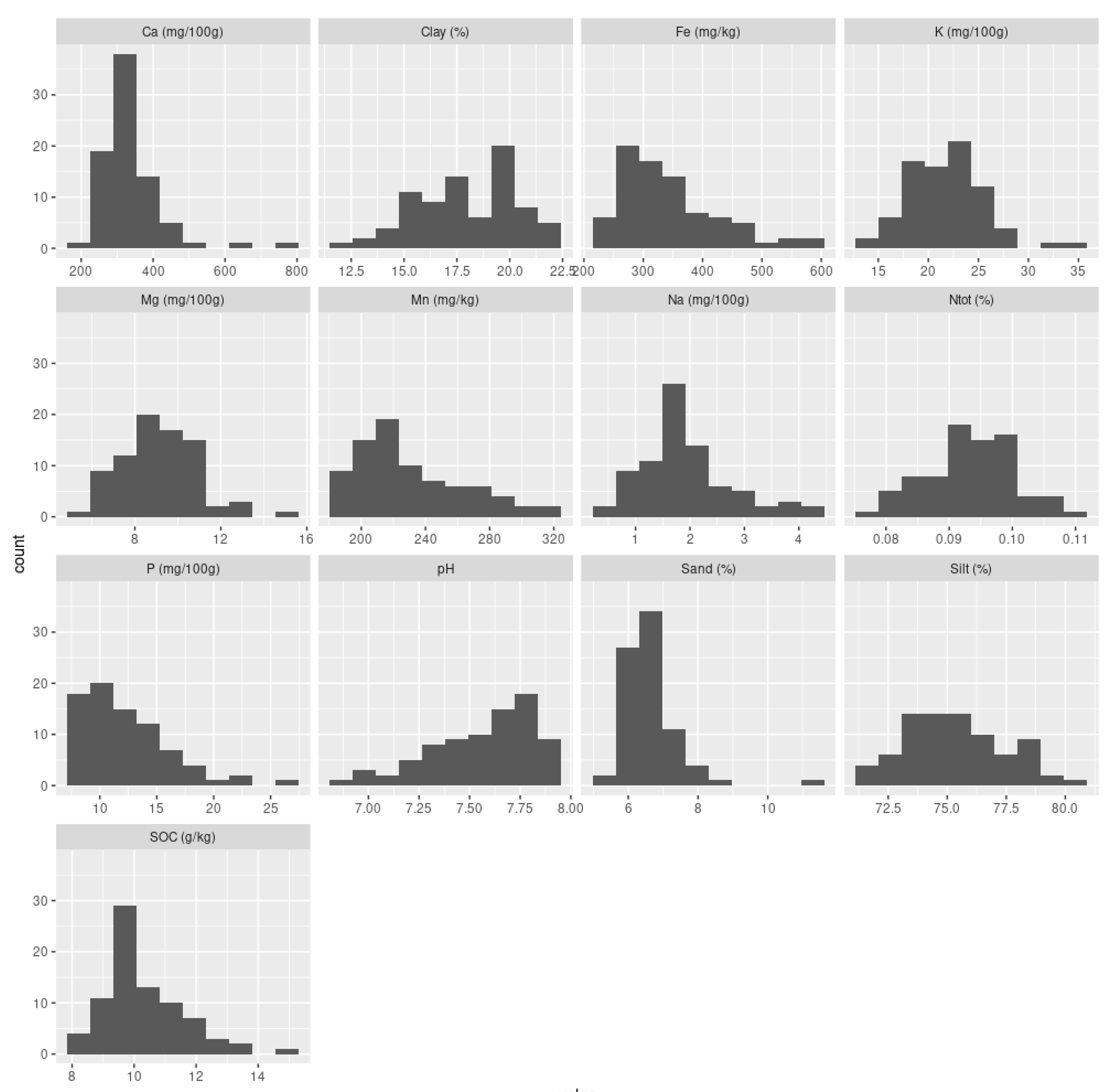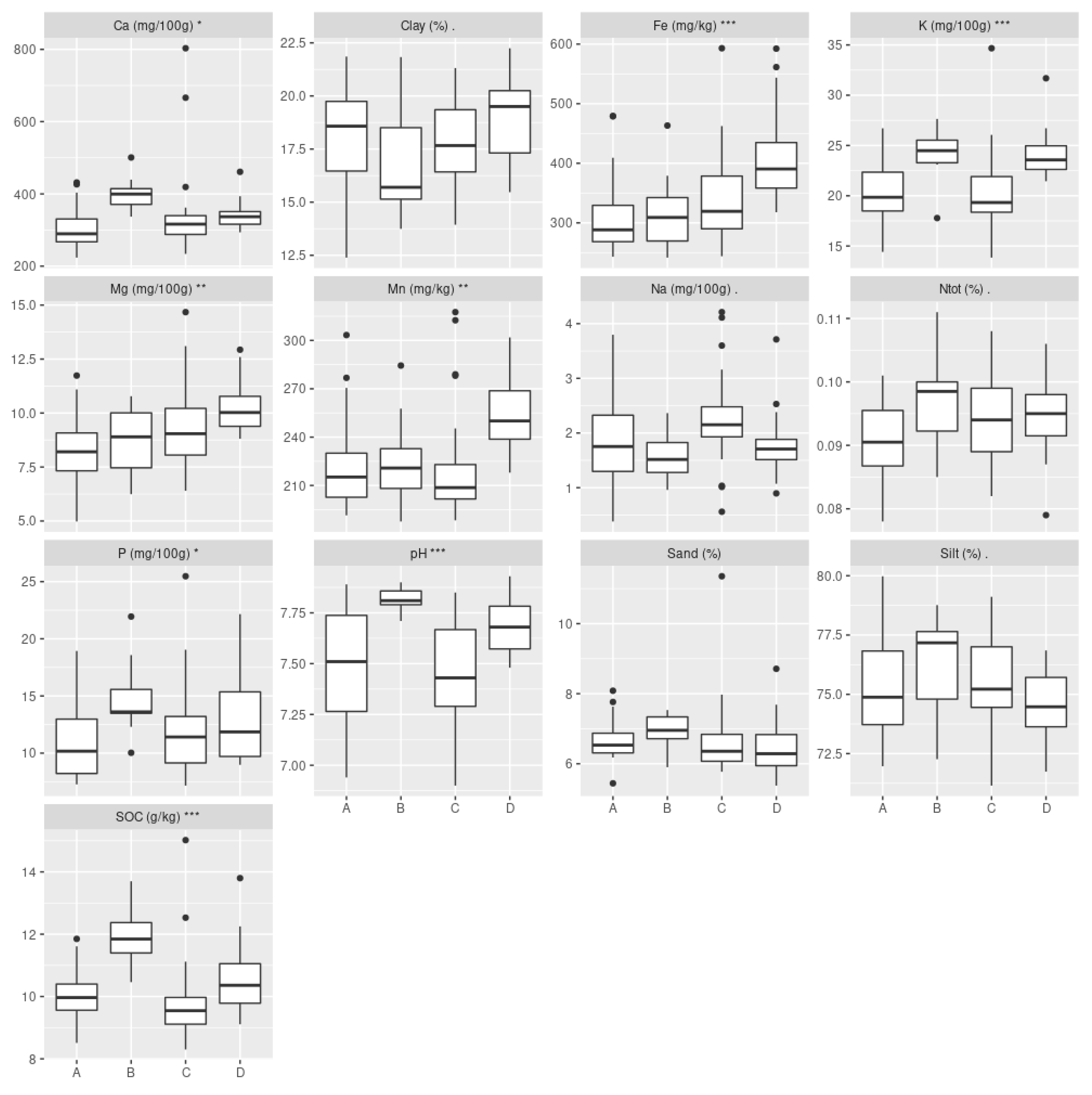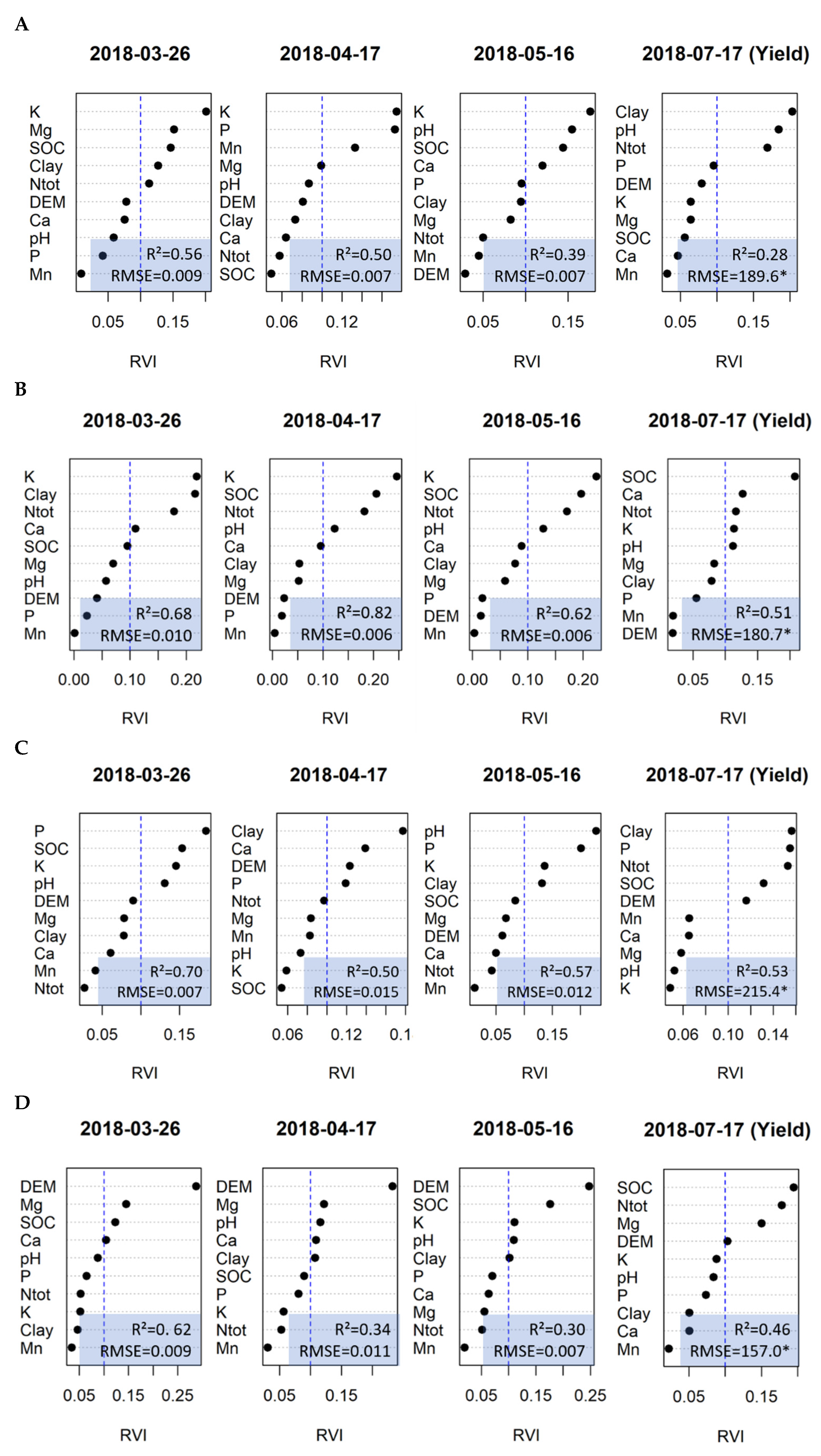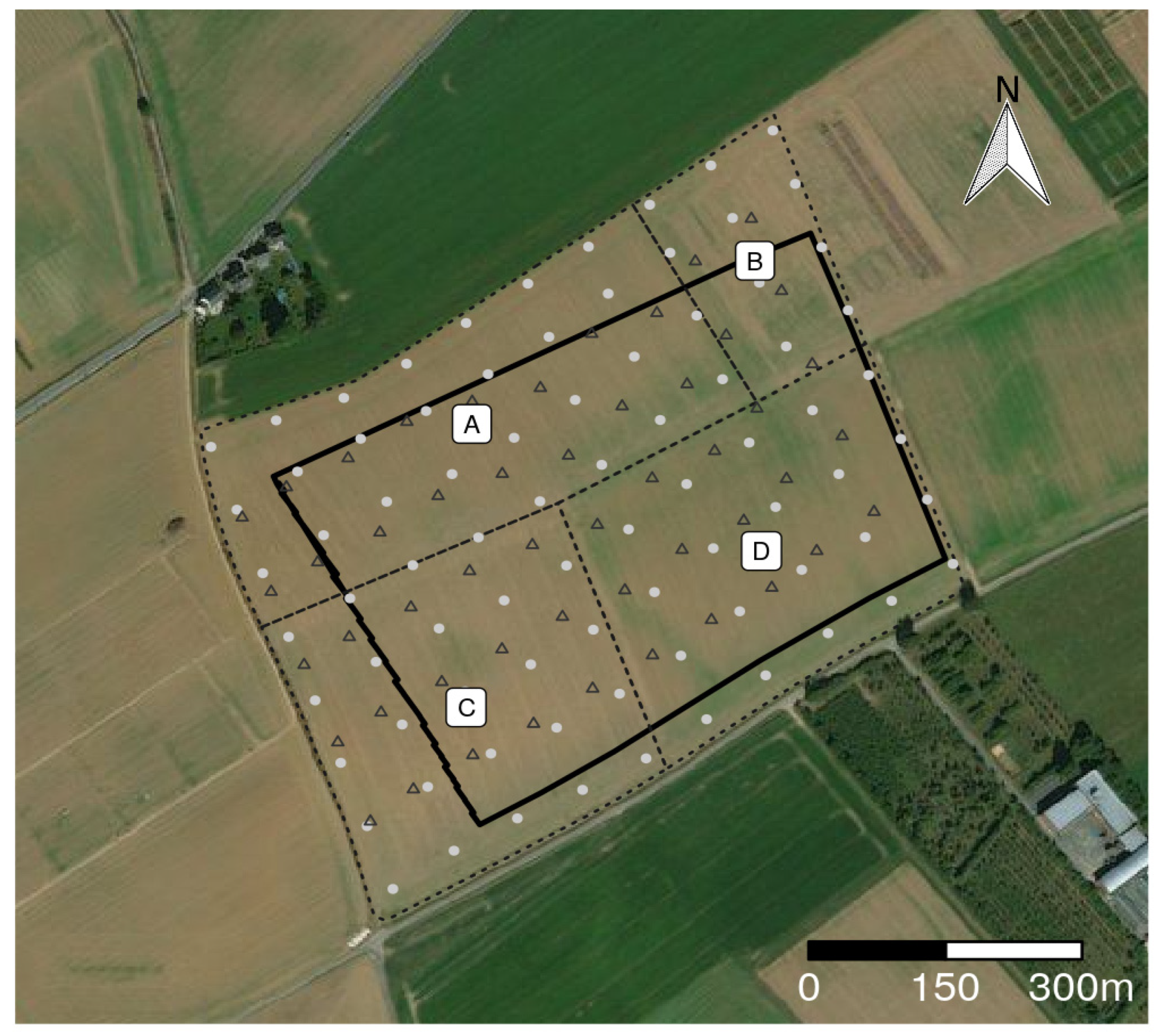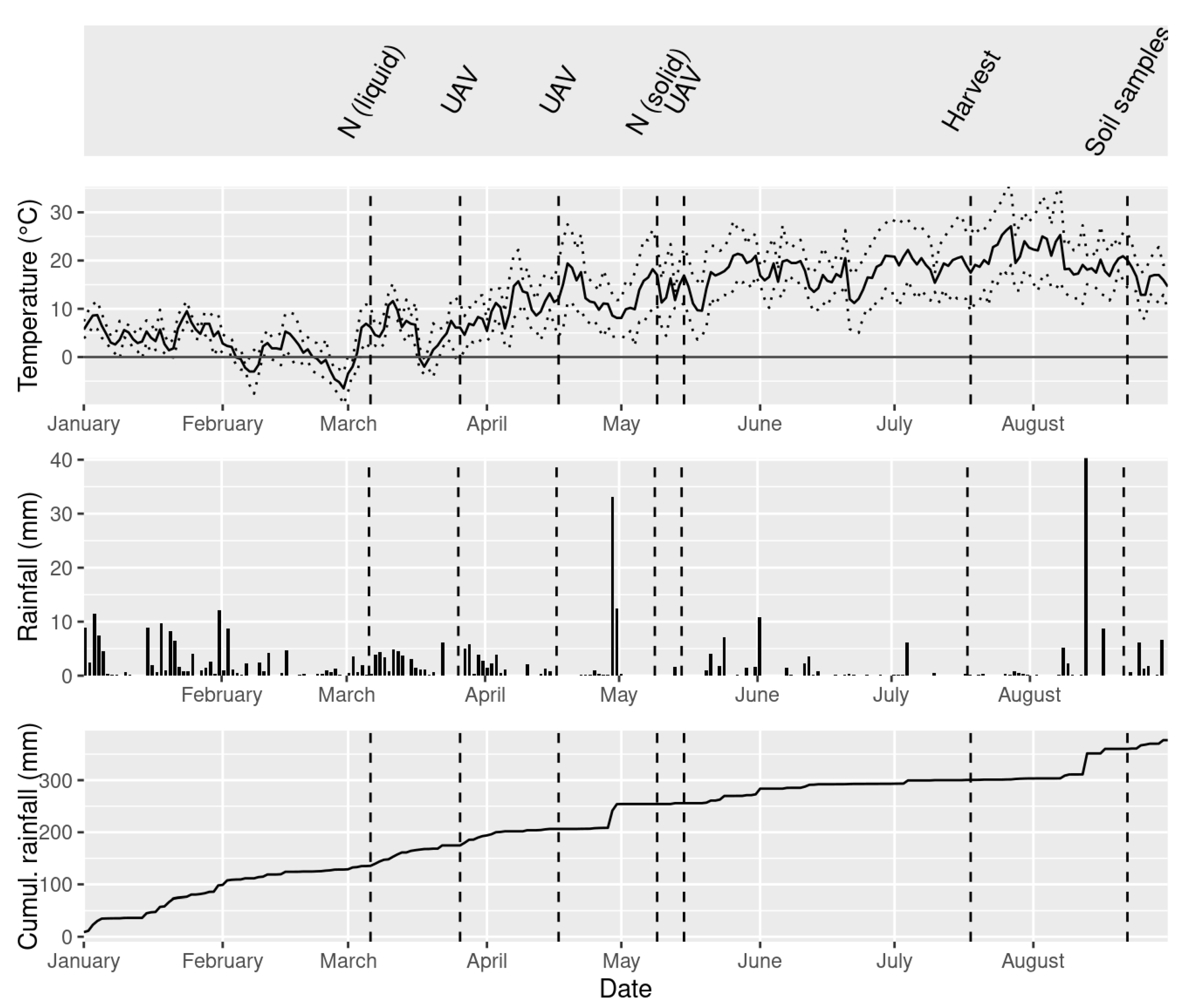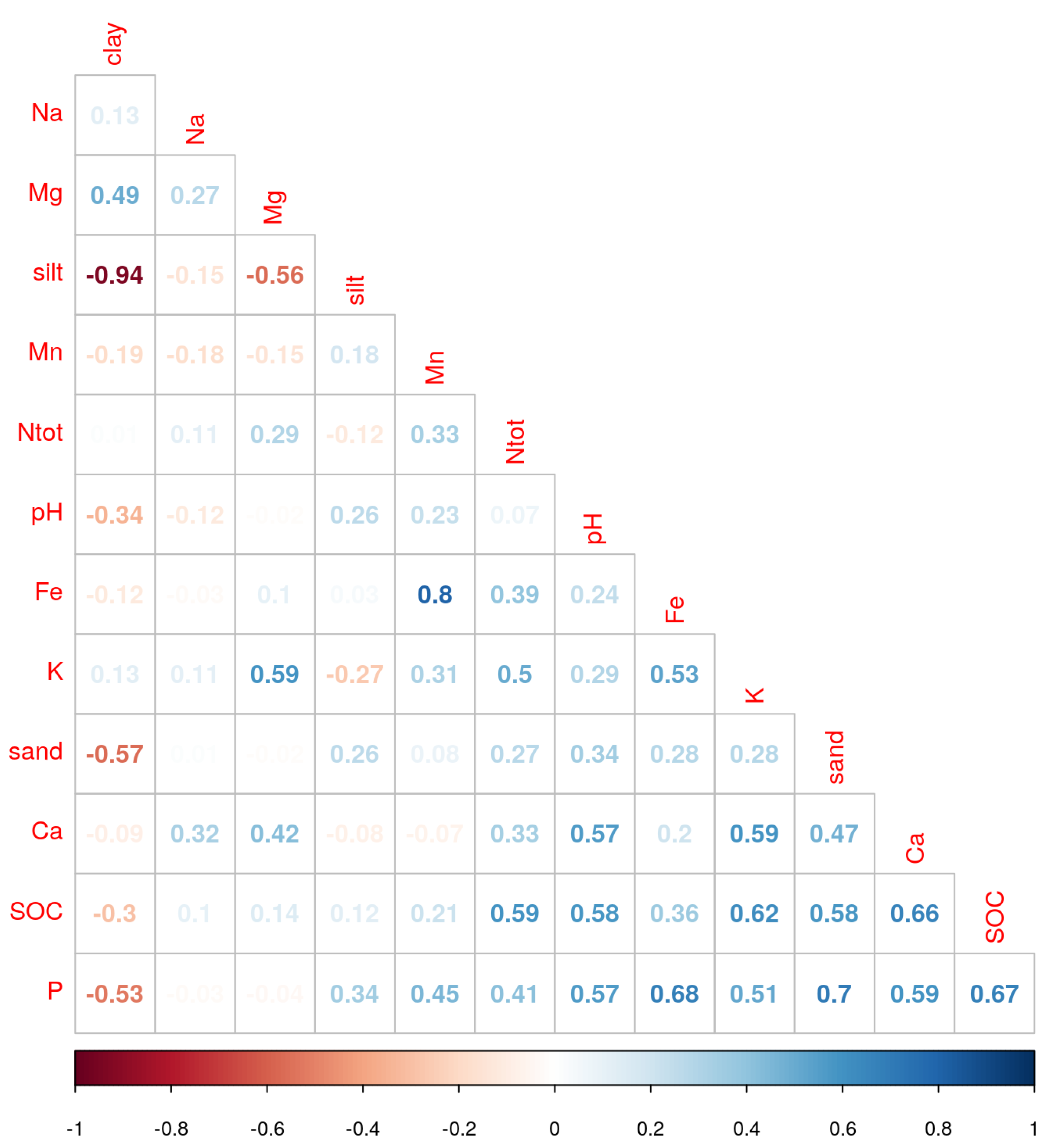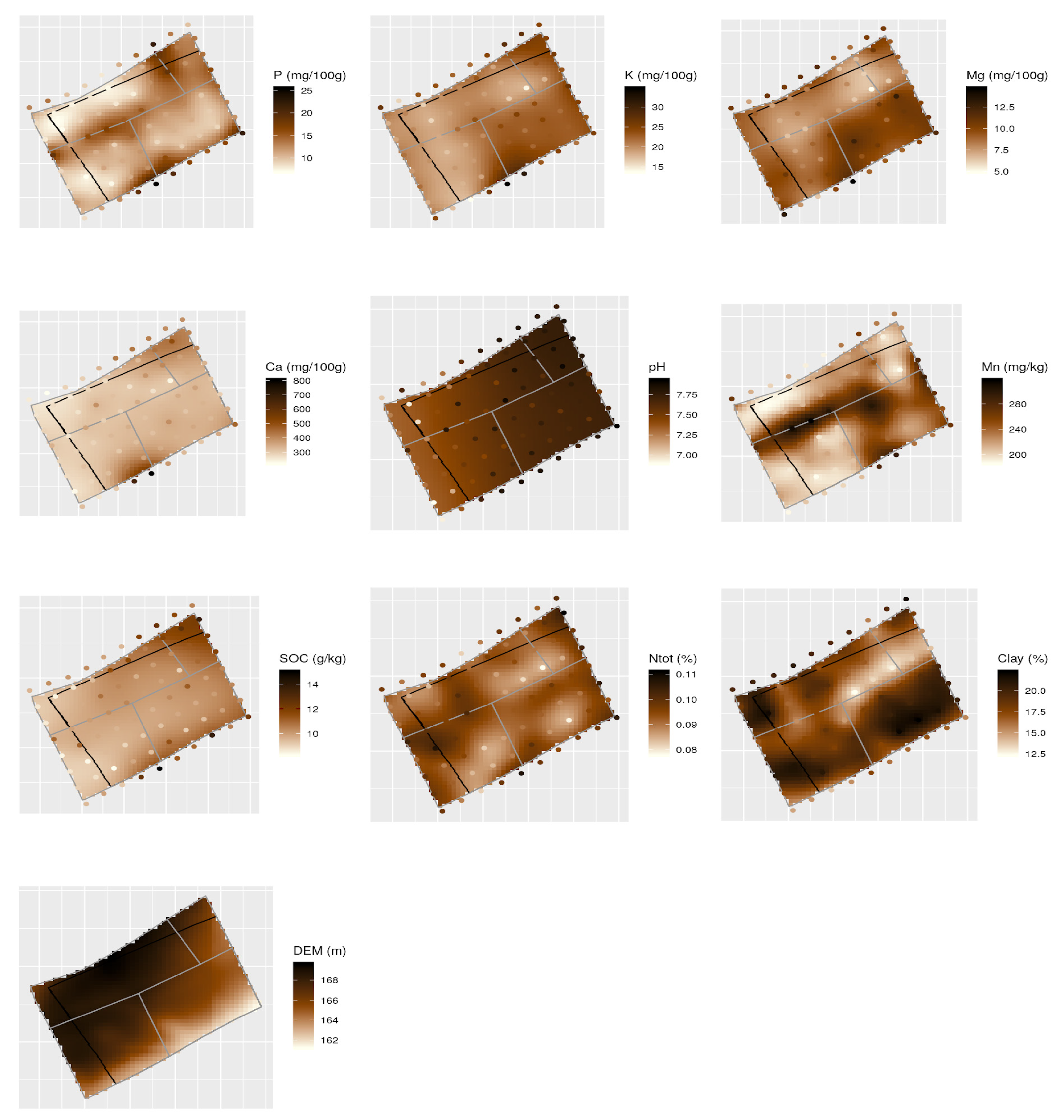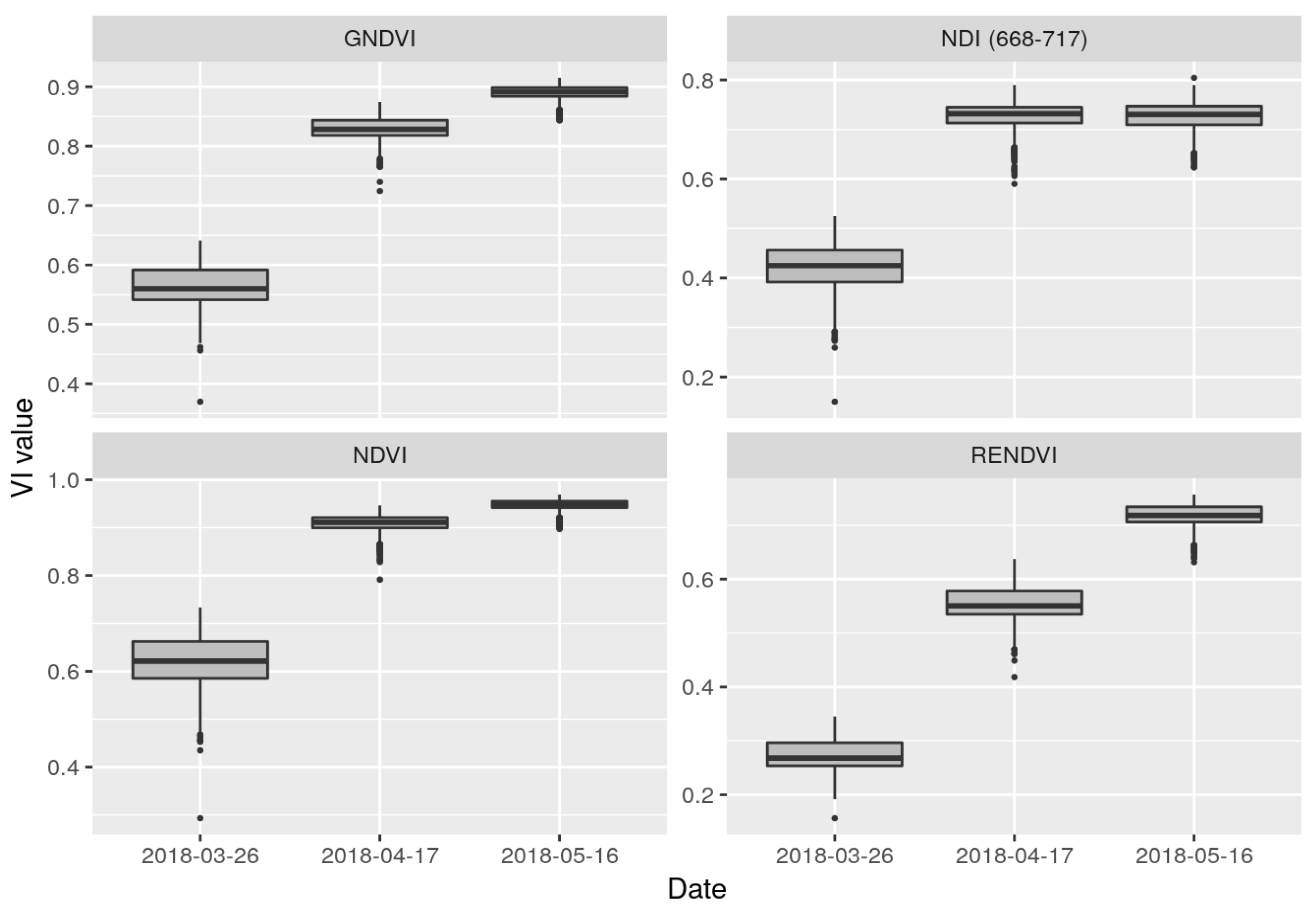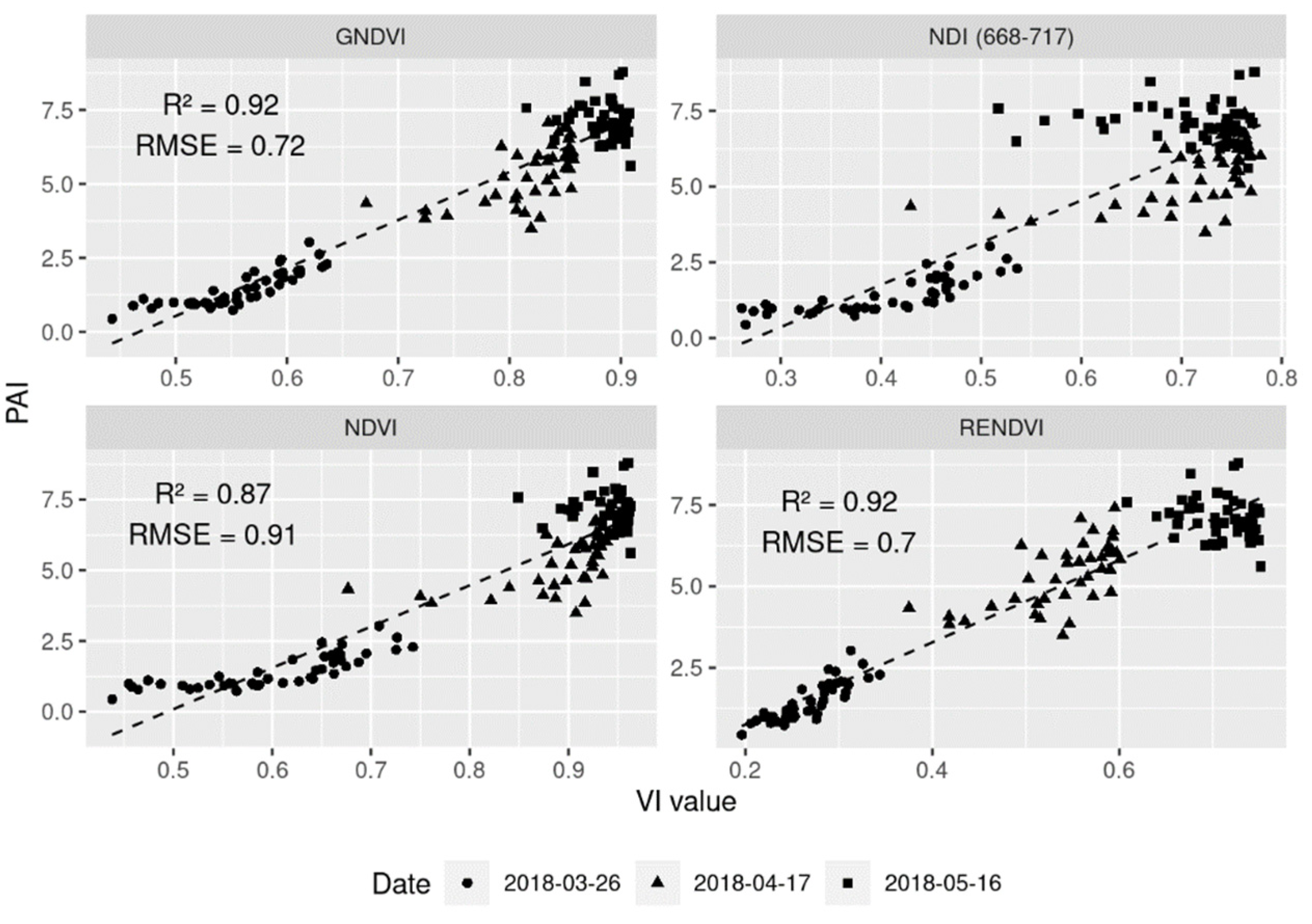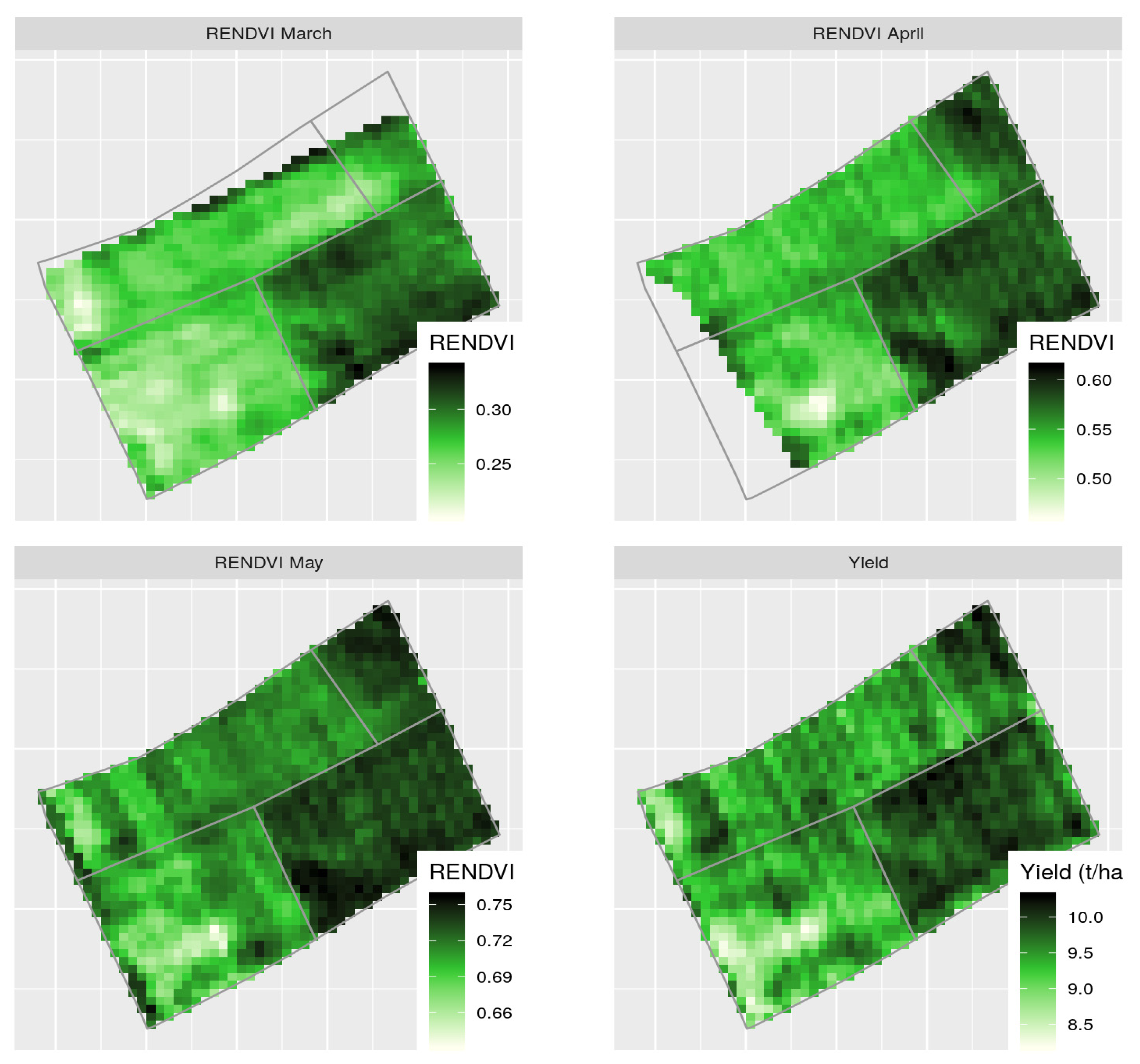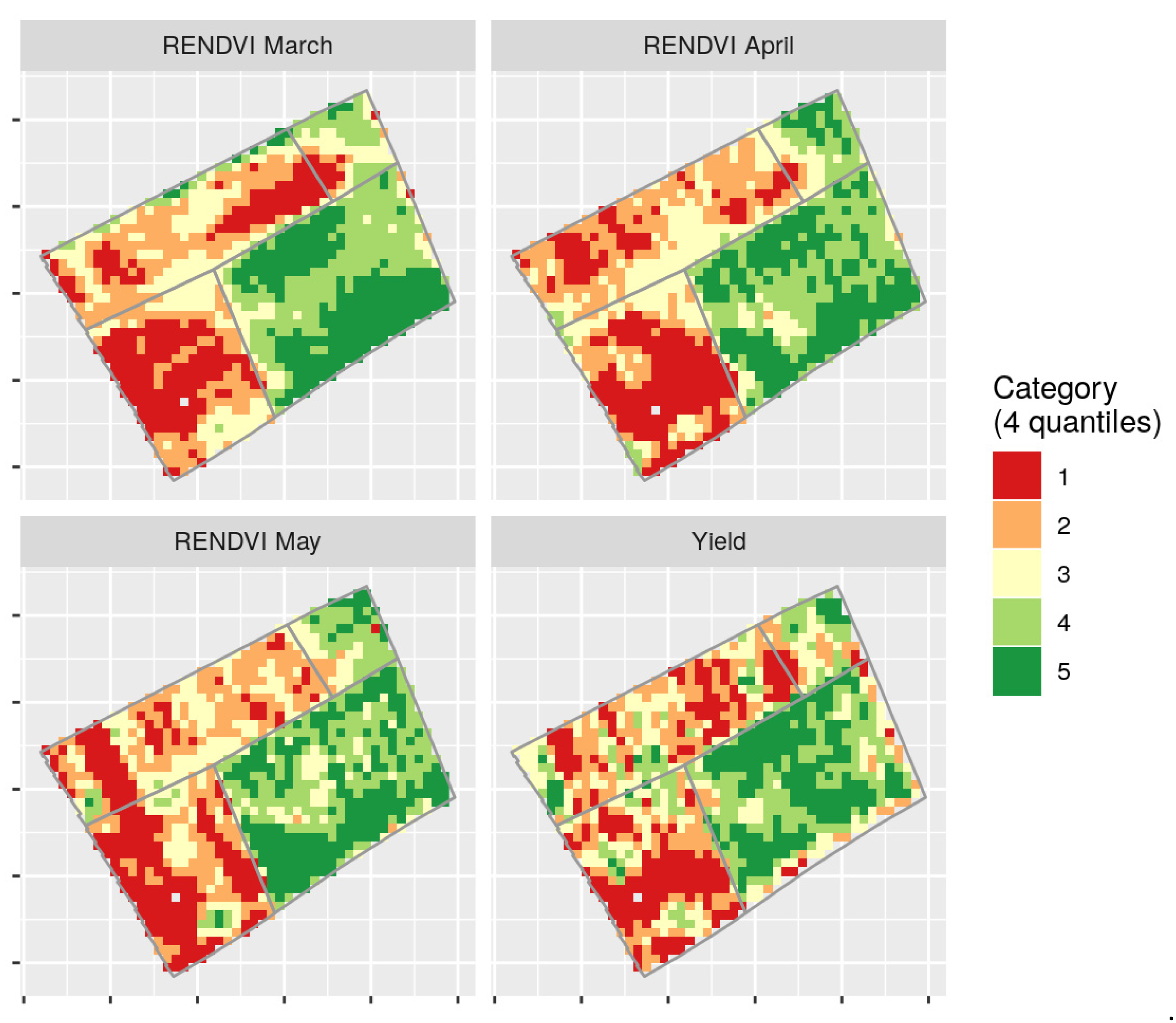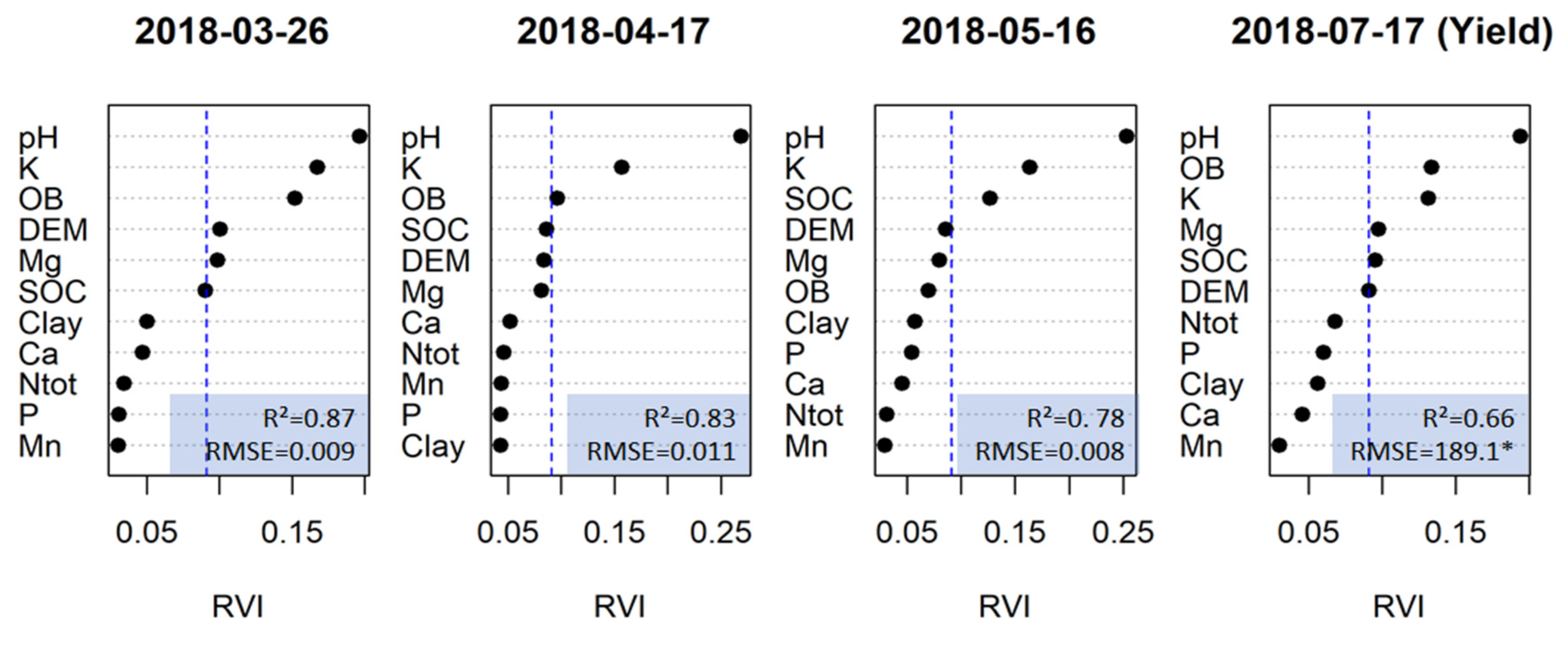1. Introduction
According to the Food and Agriculture Organization (FAO), the demand for cereals will increase by 70% by 2050 due to an ever-growing population [
1]. Currently, croplands under conventional management receive broadcasted applications of fertilizers, herbicides, irrigation, seeds, etc. [
2], while it has been shown that soil properties and crop conditions can vary considerably over space and time within a single field [
3]. In order to secure food supplies for future generations, expected amounts and quality of agricultural products, intensive but environmentally safe production, and sustainability of the resources involved are required. To meet these ends, precision agriculture emerged as a way to apply the right treatment type and amount in the right place at the right time [
4]. Gebbers and Adamchuk [
4] defined precision agriculture as “ [agriculture that] comprises a set of technologies that combine sensors, information systems, enhanced machinery, and informed management to optimize production by accounting for [spatial and temporal] variability and uncertainties within agricultural systems”. Hence, when precision agriculture is applied to a field, it is potentially divided into various management zones that each receive customized inputs, based on landscape position and soil conditions [
2].
Spatial distribution of crop growth and yield within a territory are classically expected to result, besides crop management, from basic factors such as soil characteristics, position in the landscape (field topography and soil exposure), and weather conditions. Understanding the degree of importance of the effects of these main drivers on crop growth and yield is essential in order to assess the potentialities and usefulness of applying variable rate inputs, mainly amendments (organic or calcic) and fertilizers, within a field [
5]. The most relevant properties of soil productivity are soil moisture content, clay content, organic matter content, nutrient availability, pH, and bulk density [
4]. However, spatial variations in crop yield reflect not only the influence of soil properties, site characteristics, and weather conditions, but also their complex interactions. Therefore, seasonal variation in crop growth conditions such as water stress or excess, lack or excess in nutrients, and disease, pest, and weed pressures and incidences can also greatly affect inter- and intra-annual variations in crop performance [
6]. The intra-field heterogeneity of soil properties is thereby a function of complex interactions between biological, physical, and chemical factors as well as historical management practices.
Remote sensing in agriculture allows non-contact measurements of spectral radiation reflected from crop canopy or bare soil, and has been used since the early 1970s (for an exhaustive list of studies see [
2]). With the development of remote sensing technology leading to increasing spatial, temporal, and spectral resolution, the relevance of using reflectance data from remote platforms has increased [
2]. These technological advances in remote sensing imagery coupled with a decrease in associated costs have allowed the collection of timely information on crop variability. Such information on agricultural crop status during the growing season can be used for estimating potential crop yields. Moreover, an early assessment of the risk of yield reduction acquired by timely crop monitoring could help to guide the strategic planning related to site-specific management of crop inputs, such as amendments or fertilizers. Remote sensing is frequently used to estimate spatial patterns in crop growth through the use of spectral vegetation indices (VIs), such as the commonly used Normalized Difference Vegetation Index (NDVI). However, the latter suffers from limitations when it comes to estimating the total plant biomass in fully developed crops, and the use of other spectral indexes, such as those including the red-edge bands (centered around 740 nm), is recommended [
7].
Recently, unmanned aerial vehicles (UAV) have been developed as low-cost observational platforms for environmental monitoring with an ever-increasing scientific interest [
8]. The latest advancements in sensor specifications (weight, spectral and radiometric resolutions, battery autonomy) have allowed an exponential increase of UAV applications in agriculture, as they can be easily deployed to monitor the crop during the growing season over a field or some contiguous fields.
Numerous studies have described crop growth monitoring through the use of such technologies combining remote sensing and UAVs. Lukas et al. [
9] showed that Green NDVI (GNDVI) is a reliable variable to estimate winter wheat biomass across the growing season. Schirrmann et al. [
10] showed that RGB UAV imagery is sufficient to assess winter wheat crop biophysical variables such as leaf area index (LAI) along the growing season and that there is significant variation in pattern between different dates. Barley biomass estimation can be made by combining RGB height estimation and VI. While only VI is suitable at early development stages, the combination with RGB height is more robust at advanced stages [
11].
This paper aims to explore the links between the within-field spatial variations in crop growth throughout the growing season and the spatial variability of site characteristics, current soil properties (physical and chemical), and contrasted historical soil and crop management practices. We use a case study of a winter wheat crop in 2018 (sowing in autumn 2017) in a single loamy field of central Belgium (Gembloux). Crop growth assessment was based on relevant VIs derived from in-season UAV remote sensing imagery and yield mapping sensor at harvest. Information on the current within-field spatial patterns of soil characteristics, such as soil organic carbon (SOC), nitrogen (N), phosphorus (P), exchangeable cations, pH, or physical soil texture characteristics, were collected. The objectives of the present study were (i) to test a selection of UAV-based VIs and choose the best one to accurately monitor and map in-season winter wheat crop growth heterogeneity as well as the related final grain yield; (ii) to assess, using a conditional inference forest (CI-forest) algorithm, the link between, on the one hand, the winter wheat crop growth and yield, and on the other hand, field soil properties, characteristics, and former field layout linked to contrasted historical soil and crop management practices within four previous different parcels merged into a unique field; (iii) to explore and discuss the possibilities of UAV remote sensing acquisition on a winter wheat canopy growth and yield to indirectly qualify and/or quantify the within-field spatial patterns of soil properties and characteristics, and to define potential field management variable zones. Such final information could contribute, for instance, either to an improvement in the optimization of further amendments, manures or fertilizer recommendation aiming to mitigate soil heterogeneity effect on crop, or to better contribute to in-season management of fertilizer application through site-specific management of the crop.
3. Results
3.1. Historical Soil and Crop Management and 2018 Meteorological Conditions
Soil and crop management practices data for the period 1990–2018 across the parcels of the former field layout were retrieved from CRA-W archives and compiled to create a summary of the field management practices (
Table 4 and
Table 5). The four parcels were managed in a conventional farming system throughout the period 1990–2018. The values of
Table 4 and
Table 5 are presented for four sub-periods from 1990 to 2018 to allow the illustration of the contrasted historical soil and crop management practices and also the consideration of short- to long-term effects of such practices on current soil properties. For each sub-period, values are expressed as the sum of annual values over the sub-period. The crops were grown in rotation. The main crops are the main ones for central Belgium, i.e., winter wheat (
Triticum aestivum sp.), winter barley (
Hordeum vulgare sp.), sugar beet (
Beta vulgaris subsp.
vulgaris Altissima Group sp.), maize (
Zea mays sp.), potato (
Solanum tuberosum sp.), and oilseed rape (
Brassica napus sp.).
The soil was ploughed and harrowed every year and usual crop protection products (fungicides, herbicides, insecticides) were used. Recommended N–P–K fertilization was applied according to the balance sheet method for N and the triennial balance between import and crop uptakes for P and K, applying various mineral or organic forms of fertilizers and amendments (organic or calcic).
SOC can be affected by the crop residue restitution, organic amendments (farmyard manure, slurry, waste lime), and winter cover crops (
Table 4) [
31]. Before 2009, mustard was occasionally sown as a winter cover crop. The last ten years, winter cover crops (ray-grass or mixture) were sown systematically if possible prior to a summer crop. Since 1990, there have been no remarkable differences between parcels for cover crops. Long-term observation of crop residues shows a higher occurrence on parcel D. Looking at least at the last ten years or more, more organic inputs were applied on plots B and D, which is expected to have increased their SOC content over the period.
Organic amendments also contain various amounts of minerals such as P, K, Mg, and Ca, also supplied by mineral fertilizers and amendments such as KCl, solid P–K in various proportions, Haspargit (K2O, CaO, SO3), or dolomite (CaCO3 and MgCO3).
For the 2014–2018 period, the balance between import and export of P, K, and Mg was negative, especially on parcel A (
Table 5). For 2010–2018, the balance is positive for parcel B, close to zero for parcel D, and still negative for parcel A and C. This differentiation between the A–C and B–D parcels remains for the 2000–2018 period, especially for P and K.
Ca was supplied by organic amendment (especially waste lime), Haspargit, and dolomite, which are used to lime the parcel. Waste lime was applied until 2009. Haspargit was occasionally applied in the last 20 years on each parcel and the most recent application dates back to 2014 on parcels A and B. A total of 1500 kg·ha−1 of dolomite (55% CaCO3, 40% MgCO3) was applied on plot B in 2009. According to the 2010–2018 period, a higher pH can be expected on parcels B and D.
The four parcels were merged in spring 2017 into a unique field of 17 ha. Maize was then sown over the whole field with a N–P–K supply (21%–6%–6%) of 500 kg·ha
−1 as bulk fertilizer and harvested in October. Winter wheat was sown on 27 October 2017 for the 2018 growing season. Only mineral N was supplied, with an application of 71.5 uN·ha
−1 (sulfazote) in March and 60 uN·ha
−1 (solid) in May (
Figure 2).
According to the “Bulletins Agrométéorologiques” for the year 2018 [
32], growing conditions were favorable for winter wheat at the end of winter and beginning of spring. May, June, and July were unusually dry and hot, which led to serious drought problems for summer crops.
The drought has not really impacted yields of the winter wheat up to June, but has accelerated the grain ripening, leading to early harvest in July. The crop growth observed by drone in May (
Figure 2) was thus
a priori not affected by these dry conditions, as hydric stress was not yet induced. Appropriate application of plant protection products avoided the emergence and damages due to pest and disease. Nevertheless, the dry conditions after the application of the solid N in May could have led to a non-optimal absorption and valorization by the crop.
3.2. Soil Property Assessment across the Entire Field and the Previous Four Parcels
The values of physical and chemical soil parameters are given in
Table 6. Globally, the ranges of value are close to the normal values encountered in this part of the Belgian silty (silt rate around 70–75%) region essentially dedicated to main crops. It must, however, be mentioned that the pH values of the studied field range from 7 to 8 and therefore the soil is qualified as basic. The coefficients of variation (CV) vary globally from 3% up to 42% for the soil properties across the entire field. P and Na show the highest intra-field variation, while Ntot, pH, and silt content the lowest. Distribution frequency for each soil property can be found in the
Appendix A (
Figure A1).
The results of the ANOVA tests aiming to compare the specific values within the four parcels of the former field layout reveal very highly significant differences for pH, SOC, K, and Fe values, while highly significant differences are observed for Mg and Mn, and significant differences for P and Ca. More specifically, the SNK tests reveal significantly higher pH and K values for B–D parcels compared to A–C parcels. SOC is significantly higher on the B parcel and Fe on the D parcel, as is also the case for Mn and Mg, respectively. For Ca and P, only A and B parcels show significantly higher value. To illustrate the results of the SNK test, the mean values and distributions of each soil variable in each of the four previous parcels can be found in the
Appendix A (
Figure A2).
Looking back a decade ago (period 2010–2018) and with respect to historical management practices data summary (
Table 5), the highest pH and K values in parcels B and D can be explained, respectively, according to the higher balance value (difference between imports and exports) in Ca and K applications than in parcels A and C. Additionally for the period 1990–2018, applications of much higher amounts of waste lime (a calcic amendment) on parcels B and D (
Table 4) partly explain their current higher pH values. Similarly, higher SOC values on parcel B and D are in agreement with the two to three times higher applied amounts of farmyard manure for the period 1990–2018 (
Table 4), such applications leading to an expected higher biological activity in parcels B and D.
As aforementioned, the CI-forest algorithm is sensitive to correlated predictors. Hence, amongst the highly correlated predictors (Pearson’s rank correlation coefficient ρ > 0.7) (
Figure 3), we selected those with a lower rRMSECV (
Table 7), as those provided a more accurate kriged map. Overall, silt was eliminated because of its high negative correlation with clay (ρ = −0.94), sand because of its high positive correlation with P (ρ = 0.70), and Fe because of its high positive correlation with Mn (ρ = 0.80). Moreover, Na was eliminated because of its very high rRMSECV (0.41%), resulting in a kriged map of poor quality. This is probably caused by the inaccuracy of Na laboratory analysis, well known by the reference laboratory of the Requasud network in Belgium.
The maps generated by OK (parameters can be found in
Table 7) are presented in
Figure 4. The interpolated map of SOC shows, for example, areas with higher SOC content in (i) the foot slope (parcel D) and in (ii) the northeastern area of the field (parcel B). These two parcels used to form one independent parcel until 2017.
3.3. Crop Growth Assessment
3.3.1. VI Selection
NDVI and NDI
668-717 level off in April and May, and their values seem to no longer reflect the crop growth and development of winter wheat (
Figure 5 and
Figure 6). Among the four VIs, RENDVI shows the smallest saturation effect in May. The linear regression of VI to PAI resulted in an R
2 and an RMSE of, respectively, 0.92 and 0.72 for GNDVI, 0.92 and 0.7 for RENDVI, 0.87 and 0.91 for NDVI, and 0.77 and 1.2 for NDI
668-717 (
Figure 6). It should be noted that we used the VIs derived from the UAV sensor as a proxy for the crop growth in order to map its heterogeneity within the field. For such a proxy assessment against ground-truth PAI data, we assumed that a simple linear regression was sufficient and more straightforward than, for example, partial least square or RF regressions. Based on the goodness of fit of the regressions and the evolution of the VIs throughout the growing season (
Figure 5), RENDVI was chosen as the best remotely sensed proxy for crop growth.
3.3.2. RENDVI and Final Yield Maps
RENDVI and yield maps present similar patterns throughout the growing season (
Figure 7). The effects of the former field layout on the crop growth appear, with the northeastern (B) and southeastern (D) parcels showing higher biomass and yields.
The Spearman rank correlation coefficient (Sp), calculated for all combinations of RENDVI acquisition dates and yield (pixel scale), confirms the stability of the patterns in vegetation and yield throughout time. Sp is larger than 0.8 amongst RENDVI values at the three acquisition dates and larger than 0.7 between yield and RENDVI values at each acquisition date.
Additionally, RENDVI and yield maps are displayed, classified into five groups of the same number of pixels, defined by four quantiles (
Figure 8). This allowed to highlight the time-continuity of intra-field heterogeneity along the growing season and at harvest. Moreover, this highlights more clearly the separation of the field into two main zones, defined quite well by the grouping of the A and C versus the B and D previous parcels, as it was defined by the analysis of historical management practices and soil samples. Nevertheless, these maps also show heterogeneity within each of the previous four parcels, which could be interesting to take into account in a field management variable zones approach.
3.4. Assessment of the Contribution of Soil Property Heterogeneity to In-Season Crop Growth and Final Yield Heterogeneity Using the CI-Forest Algorithm
The CI-forest models for the entire field performed very well at fitting: they explained variance of 66–87% (
Figure 9).
The crop growth was best predicted by the CI-forest model at the beginning of the growing season. By the end of March, the model explained 87% of the observed variance. Model performances decreased over time, from 87% to 66%.
K and pH were identified as the most important and stable explanatory variables for crop growth throughout the entire growing season, explaining from 15% up to 26% of the variance in crop growth and yield each. The former field layout (OB variable) was amongst the top ranked for the crop growth throughout the growing season and for the yield, except for mid-May where SOC and DEM emerged as more important splitting variables for the prediction of crop growth. In contrast, Mn, Ca, clay, P, and Ntot were not important splitting variables either for crop growth or yield in any of the CI-forest models. Mg was marginally important at the beginning of the season (end-March) and at harvest (mid-July), but this instability might be attributed to the randomness of the model. These soil parameters did not generate any heterogeneity in crop growth, meaning that they were probably not the limiting growth factors.
Given the importance of the former field layout in all CI-forest models, we carried out the same CI-forest analysis for each of the four former parcels. The results are reported in the
Appendix A (
Figure A3). Overall, the model performance decreased for each parcel compared to the results from the entire field, with the highest R
2 = 0.82 obtained for Parcel B in April, and the lowest R
2 = 0.28 obtained for parcel A in July. The interpretation of the results must be performed with care as the models have, in some cases, very poor explanatory ability. The variable importance rankings for RENDVI and yield vary strongly amongst parcels. While in the CI-forest analysis for the whole field pH was the most discriminatory variable, this is only the case for parcel C in May. On the other hand, the second most discriminatory variable for the entire field, K, is top-ranked in parcels A and B during crop growth stages. This highlights once more the impact of the heritage of former field division and of historical soil and crop management practices. Moreover, each parcel presents instability throughout time, as explanatory variables are ranked differently in the CI-forest from March to July. Parcels A and C are witnessing this effect more noticeably.
4. Discussion
Characterizing the intra-field heterogeneity of crop growth is the first step for defining field management variable zones in precision agriculture. Several combinations of “NDI” [
7] were tested to explore the possibilities of the UAV-borne MicaSense
® RedEdge-M
TM sensor to characterize the growth heterogeneity throughout the growing season. The combination of red-edge and red bands was the most suitable to show the continuity in winter wheat crop growth patterns, even at a late growing stage (mid-May). It performed better than the NDVI, classically used in precision agriculture applications [
2] and showing saturation issues between stem elongation stage (mid-April) and flag leaf stage (mid-May) of winter wheat crop. Similar patterns have been observed between RENDVI maps and yield maps (Sp = 0.7), which led us to consider RENDVI maps to be a good predictor for final yield heterogeneity. As a comparison, Maestrini and Basso [
5] showed an in-season correlation of maximum 0.5 between wheat final yield and NDVI and considered it as a good predictor for yield heterogeneity. This confirms the potential of RENDVI maps to characterize the winter wheat crop growth and yield.
OK is known to be a robust method to produce soil properties maps for agricultural applications [
22,
23,
24]. Our study confirmed its robustness considering the small relative RMSECV obtained for kriged soil property maps (maximum 0.24).
CI-forest models showed the strong influence of soil properties heterogeneity on crop growth heterogeneity. This link is stronger early in the season (March) and decreases until harvest, potentially illustrating an increasing effect of intra-annual variability on the heterogeneity of the crop growth. According to the variable importance analysis, DEM and SOC importance raised in mid-May. Topography is closely related to concentration of runoff at the footslopes. A positive correlation has been found between soil wetness and SOC in numerous studies [
33,
34,
35]. Between the 17 April 2018 and 15 May 2018 UAV flights (28 days), there was a total of 49.5 mm precipitation, 33.1 and 12.4 mm of which fell in 2 consecutive days at the end of April (
Figure 2). Hence, this period was quite dry and the heavy rain storms have probably led to concentration of runoff and higher moisture contents in the soils of the lower part of the field. We therefore hypothesize that the crop growth at the end of the growing season was faster where more soil moisture was available.
According to the CI-forest variable importance analysis, the soil properties related to the most crop growth and yield heterogeneity were K and pH and, to a lower extent, SOC and Mg. In this study case, they can therefore be considered as limiting factors for the crop growth and final yield on at least part of the field and we can analyze whether these are parameters that should be taken into account primarily in such a field to apply a management zones approach. In the conditions of the silty soils of the Belgian loam belt and ideal crop growing conditions, Van Koninckxloo and Brassart [
36] described optimal values for the abovementioned soil properties as follows: pH = 6.9; K = 16 mg/100 g; Mg = 12 mg/100 g; SOC = 1.25 g/100 g. Keeping in mind that soil was sampled after the harvest of winter wheat crop, which received no input other than nitrogen and has a low demand for other nutrients, it is interesting to compare such values with our data and results from the CI-forest analysis. Considering firstly the average values over the whole field area, pH values ranging from 6.9 to 7.9 can be qualified as alkaline values higher than the optimal. However, according to Fernandez and Hoeft [
37], such basic pH values are still adequate for winter wheat crop growth. K values ranging from 13.8 to 34.7 mg/100 g are close to or higher than the optimal value. SOC values ranging from 0.8 to 1.5% are mainly lower than the optimal ones. Mg values ranging from 5 to 14.7 mg/100 g are also generally too low compared to optimal values. For the four soil properties identified in our study as linked to the winter wheat crop growth and final yield heterogeneity, such value range fluctuations with raw values are quite distant from the expected optimal ones, indicating the potential to discriminate management variable zones within the field, based on the use of UAV-embedded multispectral sensor and RENDVI image acquisition. Considering the crop growth and final yield heterogeneity over the four previous parcels from the former field layout, parcels B and D clearly indicate higher crop growth and yield values compared to parcels A and C (
Figure 7). Similarly, mean values of variables pH, K, and SOC were also significantly higher within B and D parcels, while Mg showed significantly higher value in parcel D only. Considering pH and K factors, as stated above, it is not known from the literature that increasing values of both factors, per se, has increasing effect on winter wheat crop growth and yield, but it could be argued that the interaction of both can explain differences in crop growth and yield. Indeed, as mentioned before, pH values are quite alkaline and could partially reduce the availability and plant assimilation of K in this value range [
38], but pH limitation is probably not the only explanation, because, as stated by IPNI [
39], availability and uptake of K is often complicated by many interacting components such as soil and plant characteristics and also fertilizer and management practices. For soil, one can mention, for instance, its cation exchange capacity, the amount of available K in the soil solution, the K fixation of the soil, or the nonexchangeable or slowly available K. K is also known to interact with almost all of the essential macronutrients, secondary nutrients, and micronutrients, so that crop growth and yield can be affected. As K amount in B and D parcels are higher, this limitation could be mitigated so that induced deficiency effect of K on crop growth and yield is much lower or even avoided in both B and D situations. On the contrary, a direct effect of higher SOC values in B and D parcels can explain increase in crop growth and yield. This is supported by a global meta-analysis conducted by Oldfield et al. [
40], showing that winter wheat yield increases with SOC until it levels off at SOC contents of 2%. This can be explained through the soil biological activity that increases with higher SOC content. Finally, the effect of Mg soil content is to be related to K effect as both nutrients show quite similar behavior in the soil–plant relationship. From this analysis, it is important to conclude that not only the single effect of limiting or boosting factors on crop growth but also their complex interactions need to be taken into account.
The analyses and discussion in the previous paragraph illustrate the link that is established in our case study between crop growth heterogeneity assessed through UAV spectral sensor and the observed and geolocalized heterogeneity in specific physical and chemical soil parameters, leading to the identification and localization of management variables zones within a field. We considered one growing season after the consolidation of four former fields two years earlier. The former fields were managed differently and this remarkably impacted the soil nutrients availability, the pH, and the SOC, as reflected by the historical management data analysis and the soil sampling analyses. This difference in historical management induced crop growth heterogeneity, as depicted by the crop growth maps. Management zones based only on the former field layout and the historical management, with the definition of two main zones: A–C and B–D former parcels, would already allow a good enhancement of organic and calcic amendments or fertilizers management. In our case study, crop growth spatial patterns are a strong indicator for the legacy of management on soil properties.
Given the observed strong link between some soil property heterogeneity and winter wheat crop growth, especially at the tillering stage, we can assume that it would be possible to describe the heterogeneity resulting from the combination of soil properties limiting crop growth on at least part of the field from an early-season crop growth map. In our case, the heterogeneity of the crop growth at tillering is representative of the heterogeneity of pH and K, themselves strongly correlated to the former field management and layout. As these crop growth patterns are related to soil properties, the patterns can therefore be useful for the identification of soil sampling areas. Taking enough soil samples to characterize the heterogeneity of the field is essential to achieve an optimal site-specific management. Such an operation completed for this study is labor-intensive and represents a significant cost (approximately 25 euro per sample) for the farmer, but these data can allow the farmer to save inputs by applying a management zones approach for several years on its field. This sampling must be carried out at the most relevant locations to properly characterize the heterogeneity of a field while optimizing the number of samples required and therefore the cost of the operation. The analysis of winter wheat crop growth, especially at the beginning of the growing season, near the tillering stage, allows a characterization of soil-induced heterogeneity by dividing the field into zones that could be taken into consideration to target soil analyses and then be used as management zones. Soil analysis remains important and can be completed or replaced by remote sensing of bare soil to create objective maps of soil properties, such as SOC [
41], or textural properties [
42].
